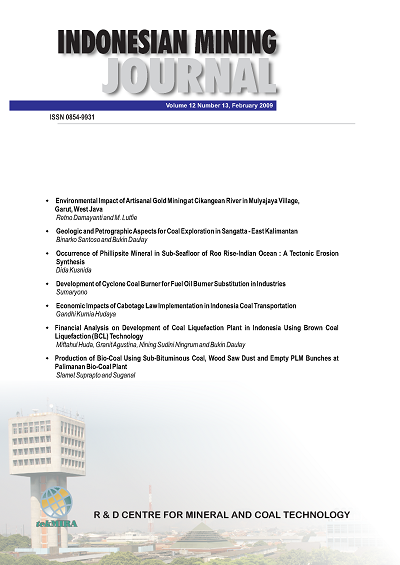GEOLOGIC AND PETROGRAPHIC ASPECTS FOR COAL EXPLORATION IN SANGATTA-EAST KALIMANTAN
DOI:
https://doi.org/10.30556/imj.Vol12.No1.2009.572Keywords:
geology, petrography, exploration, type and rank of coalAbstract
The Miocene Sangatta coals indicate similarities and differences in type and rank characteristics. The phenomena express the geological setting that includes the stratigraphic aspect and the pres- ence of intrusive body. The stratigraphic aspect relates to geologic age and cover thickness; the lower coal seam having a thicker cover has a higher rank than the upper coal seam. The intrusive body changes the rank of the coal up to semi-anthracite. The coals that are not affected by the intrusion have rank of brown coal to subbituminous. The rank of the coals increases from east to west toward the Meratus Range due to the cover thickness, where the western part has a thicker cover than the eastern part. These geological phenomena could be an exploratory target for the prospective coals.
References
Agency for Geology, 2009. Mineral and coal re- sources 2008. www.esdm.go.id. Jakarta.
Bustin, R.M., Cameron, A.R., Grieve, D.A. and Kalkreuth, W.D., 1983. Coal petrology: its prin- ciple, methods and applications. Geological Society of Canada, Short Course Notes, 3, Victoria, 273 p.
Cook, A.C., 1975. The spatial and temporal varia- tion of the type and rank of Australian coals. In: Cook, A.C. (ed.), Australian black coal-its occurrence, mining, preparation and use. Australasian Institution of Mining and Metal- lurgy, Illawarra Branch, p. 66-83.
Darman, H. and Sidi, F.H., 2000. An outline of the geology of Indonesia. Indonesian Association of Geologists, Jakarta, p. 69.
Daulay, B. and Santoso, B., 2008. Characteris- tics of selected Sumateran Tertiary coals re- garding their petrographic analyses. Indone- sian Mining Journal, vol.11 no.10, February 2008, p. 1-18.
Katili, J.A., 1989. Evolution of the Southeast Asian arc complex. Geology of Indonesia, 12, p. 113- 143.
Robertson Research (Australia) Pty. Ltd., 1984. Recent coal developments in East Kalimantan, Indonesia and potential markets in the West Pacific. Report No.1175, 263 p (unpublished).
Santoso, B. and Daulay, B., 2005. Type and rank of selected Tertiary Kalimantan coals. Indo- nesian Mining Journal, vol.8 no.2, June 2005, p. 1-12.
Santoso, B. and Daulay, B., 2006a. Geologic in- fluence on quality of selected Tertiary Barito coals. Indonesian Mining Journal, vol.9 no.5, June 2006, p. 14-22.
Santoso, B. and Daulay, B., 2006b. Coalification trend in South Sumatera Basin. Indonesian Mining Journal, vol.9 no.6, October 2006, p. 9-21.
Santoso, B. and Daulay, B., 2007. Maceral and mineral analyses of Lebak coals regarding their utilizations. Indonesian Mining Journal, vol.10 no.8, June 2007, p. 1-9.
Sikumbang, N., 1986. Geology and tectonic of pre- Tertiary rocks in the Meratus Mountains, Southeast Kalimantan, Indonesia. PhD The- sis, the University of London, 400 p (unpub- lished).
Smith, G.C., 1981. Tertiary and Upper Cretaceous coal and coal measure sediments in the Bass and Gippsland Basins. PhD Thesis, the Uni- versity of Wollongong, Wollongong, 331 p (un- published).
Stach, E., Mackowsky, M.Th., Teichmuller, M., Taylor, G.H., Chandra, D. and Teichmuller, R., 1982. Stach’s textbook of coal petrology, 3rd edition, Berlin, Stuttgart, 535 p.
Standards Association of Australia, 1975. Aus- tralian Standard AS 1676: methods for the sampling of hard coal, Sydney, 144 p.
Standards Association of Australia, 1986. Aus- tralian Standard AS 2856: coal macerals analysis, Sydney, 24 p.
Standards Association of Australia, 1989. Aus- tralian Standard AS 2486: microscopical de- termination of the reflectance of coal macerals, Sydney, 22 p.
Thamrin, M., 1987. Terrestrial heat flow map of Indonesian basins. Proceedings of Indonesian Petroleum Association, 16th Annual Conven- tion, Jakarta, p. 1-59.
Downloads
Issue
Section
License
Indonesian Mining Journal provides immediate open access to its content on the principle that making research freely available to the public to supports a greater global exchange of knowledge.

This work is licensed under a Creative Commons Attribution-NonCommercial 4.0 International License.













